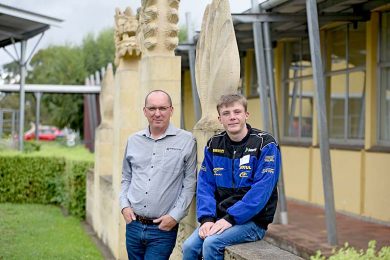

THE region’s forestry sector is sowing seeds of interest among high school students to shore up its future workforce.
Fourteen secondary students have taken their first steps this week in carving a career in the forestry industry, which employs thousands of people across the region.
The Green Triangle forestry sector – home to the nation’s largest cluster of timber processors – hopes this program will encourage students to choose a career in the vibrant industry.
The Ultimate Renewable Forest Learning Pathway inaugural program equips secondary students with the knowledge and skills to join the industry with a Certificate III and SACE credit points.
OneFortyOne spokesperson Paul Hartung welcomed the cohort of students and told participants the forestry sector was an “awesome industry” to forge a long and successful career.
“We are excited to have you here today because we believe this is a pretty great industry,” Mr Hartung told participating students gathered at Mount Gambier High School.
Mr Hartung – who manages one of Australia’s largest sawmill operations in Mount Gambier – revealed he started in the industry at the bottom of the chain.
“When I started in the industry I was strapping packs by hand – I was the last guy on the line,” said Mr Hartung, who explained this was now a fully automated process.
“I had to work my way through and learn everything.”
But he said the industry had unlocked amazing opportunities for him.
“I have worked in five states, worked with seven major players and have travelled through Europe, Germany, the United States and Canada, it is an awesome industry to be part of,” Mr Hartung said.
He said the timber industry was entrenched in the Green Triangle and the sector “helps Mount Gambier to be the place it is”.
The industry has significantly evolved and now has “incredible technology”, including cutting-edge processing equipment and drones that fly over forests to check trees.
“Another amazing thing you will learn along the way is what our industry does for climate change – it restores the carbon that stays in the timber for its entire lifetime,” he said.
“We are one of a very few industries that positively impact on climate change.”
He said new innovations on ways to use woodfibre and grow trees were also being rolled out.
“That’s why we are so excited to see such a young vibrant group come through the program,” the industry executive said.
The program will give students in the Limestone Coast an unique experience of theory and practice in the forestry industry and a “leg up” into the sector.
“Forestry is a critical industry for the Limestone Coast region, but there is currently an industry skills shortage,” he said.
“OneFortyOne has invested in the forest learning pathway because we want to develop the skills we need locally as we plan for our future workforce.
“By completing this program, students will be well-positioned for future career pathways including apprenticeships, traineeships and tertiary qualifications in the industry.
“It means those students will have a head start over others looking for work and career opportunities.”
The inaugural year of the program has seen 14 students sign up to the initiative from Mount Gambier High School, Grant High School, St Martin’s Lutheran College, Tenison Woods College and the Independent Learning Centre.
The pathway program incorporates a range of classroom and field-based experiences.
Students will also undertake several competencies from the forest growing and management, harvesting and haulage and sawmilling and processing training packages, which have been nominated by industry to support relevancy and access to future pathways.
“As a result of the program, we hope to educate students about the career options available in forestry, build momentum and interest among a wider range of students, grow talent within the community and offer professional options for their development,” Mr Hartung said.
The Green Triangle generates more than $778m gross regional product annually and boasts more than 355,000 hectares of softwood and hardwood plantations produce timber for local manufacturing, national and export markets.
The program’s partnership includes the Department of Education and Child Development, Logging Industry Training Association and the Forest Industries Training Network.









